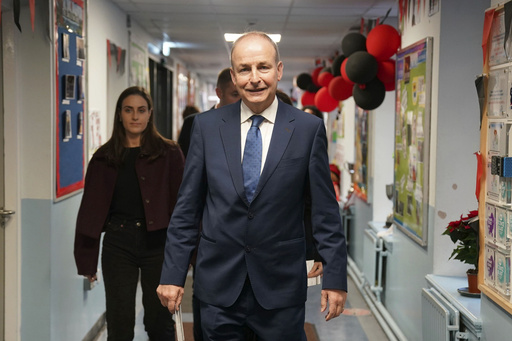
DUBLIN — On Saturday morning, Ireland commenced the vote counting for the national election, following the release of an exit poll indicating a tightly contested race among the nation’s three main political parties.
Ballot boxes were opened at 9 a.m. (0900 GMT) across various count centers, launching what may extend into long hours or even days of tabulating the election outcomes. Should the exit poll predictions come to fruition, it could lead to a protracted period of negotiations to establish a coalition government.
The exit poll results reveal that voter support is fairly evenly distributed among the three significant parties—Fine Gael, Fianna Fail, and Sinn Fein—along with several smaller factions and a number of independents spanning the left to the far-right spectrum.
According to the poll, Fine Gael, a center-right party, emerged as the favorite for 21% of voters, with Fianna Fail close behind at 19.5%. Meanwhile, the left-leaning opposition party Sinn Fein received 21.1% support.
Pollster Ipsos B&A surveyed 5,018 voters nationally regarding their ballot choices, with a margin of error of plus or minus 1.4 percentage points. These figures provide an initial understanding of voter preferences but do not clarify which parties will ultimately create the next government. Ireland employs a complex proportional representation system, where each of the 43 constituencies elects several representatives and voters rank candidates in order of preference. This system can prolong the process of announcing complete results.
The election outcome will reveal if Ireland defies the global trend of incumbents facing rejection from discontented voters due to the ramifications of the pandemic, international unrest, and rising living costs.
In the lead-up to the election, the cost of living, particularly highlighted by an acute housing crisis, was a central subject of discussion during the three-week campaign, along with immigration, which has emerged as a significant and emotionally charged concern in a nation traditionally marked by emigration.
The existing government, led by Fine Gael and Fianna Fail—two parties that have shaped Irish politics for the past century—maintains similar political platforms, despite their historic rivalry dating back to opposing factions from the Irish civil war of the 1920s. After the 2020 elections resulted in a hung parliament, they joined forces to create a coalition government.
Preceding the election, experts suggested that the most probable outcome would be another coalition involving Fine Gael and Fianna Fail. While this scenario remains feasible, both parties would need to collaborate with smaller factions or independents to secure a majority in the Dail, which has 174 seats in the lower house of Parliament.
Sinn Fein made significant strides in the 2020 general election, capturing the popular vote but was excluded from power as Fine Gael and Fianna Fail chose not to collaborate, citing concerns over its leftist agenda and links to the Irish Republican Army during the decades-long conflict in Northern Ireland.
Although Sinn Fein, which aspires to unite Northern Ireland with the Republic of Ireland, could potentially emerge as the largest party in the Dail, it may face challenges in forming a government due to its inability to secure enough coalition partners. Both Fine Gael and Fianna Fail indicated that they would reject any coalition with Sinn Fein during the election campaign.
The party, which encouraged voters to opt for a transformative change, expressed optimism following the release of the exit poll results. “There is every chance that Sinn Fein will emerge from these elections as the largest political party,” stated Matt Carthy, Sinn Fein’s director of elections, in an interview with broadcaster RTE on Friday night.
